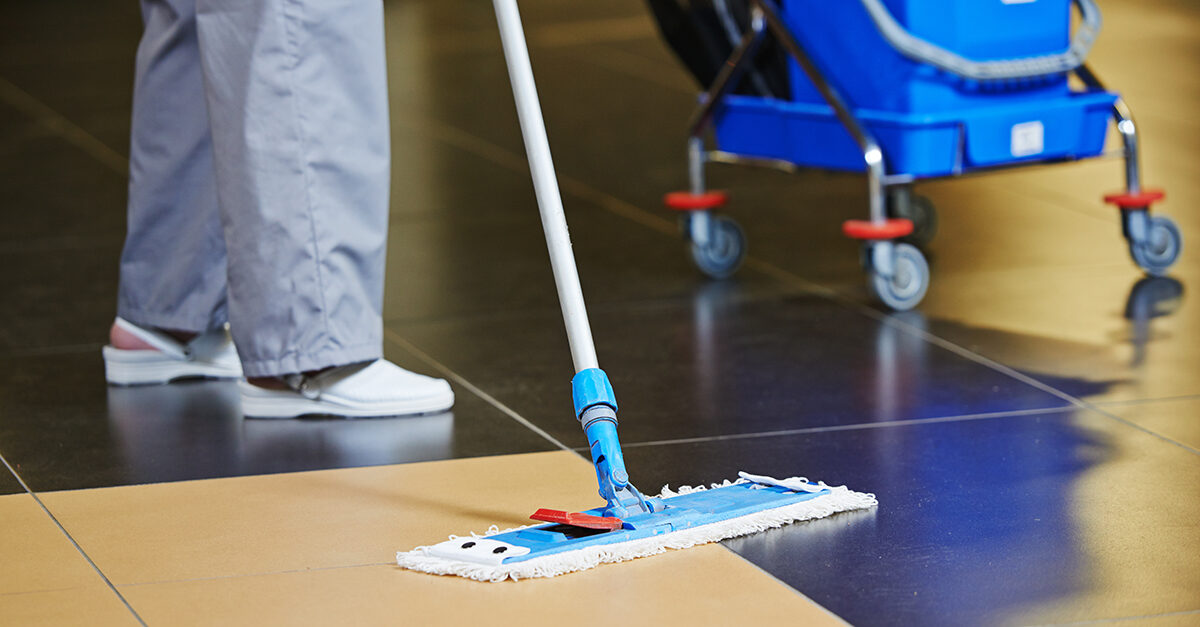Thomas W. Stewart sparked the first wave of change in floor cleaning when he patented the string mop in 1893. His invention allowed floor cleaners to rise from their hands and knees to a standing position.
The string mop was so successful it became the paradigm for floor care for the next 100 years. Adjunct equipment such as a rolling bucket with mop wringer, a deep sink for emptying the mop bucket, and a custodian’s closet on every facility floor soon followed to assist the new moping process.
The microfiber flat mop ushered in the second wave of change a century later, at the end of the 1990s. The microfiber flat mop was easier to use, utilized 98.6% less water and chemicals, and sped up the cleaning process, as cited in the U.S. Environmental Protection Agency’s paper, “Using Microfiber Mops in Hospitals: Environmental Best Practices for Health Care Facilities.”
Realize the cons of reusable microfiber
Microfiber flat mops have become more popular over the past 20 years. However, recent studies show their strengths can actually hamper the cleaning and disinfection process. A 2016-2017 study found the microfiber’s ability to gather and hold dirt negatively impacted the mop-laundering process.
Researchers gathered 15 newly laundered flat microfiber reusable mops from six participating hospitals and tested them for microorganisms at a third-party independent laboratory. Six (40%) of the 15 mop samples contained microbiological contamination, including the health care-acquired (HAI) pathogens Methicillin-resistant Staphylococcus aureus (MRSA) and Clostridium difficile (C. diff). These results confirm similar testing of microfiber cleaning towels, as published in the American Journal of Infection Control.
The laundering process for reusable microfiber flat mops uses fabric softeners and other chemicals, requires washing at 160-200 degrees F, and then drying at 130 degrees F. This heat causes the microfibers to melt, which inhibits the mops’ retention qualities.
Researchers took eight of the laundered flat microfiber mops from the study to the North Carolina State University School of Textiles, where they studied and photographed them under 20 times and 40 times enlargement using a 3-D stereo microscope, then under 1,000 times enlargement using a scanning electronic microscope. The photos showed significant contamination and degradation of the microfibers. In some cases, the microfibers were completely melted and contained foreign materials.
This damage to the microfibers can result in “binding,” which in turn causes the mops to release chemical disinfectants, resulting in an ineffective floor disinfection process. Proper disinfection is especially critical for floor care in hospital operating rooms, isolation rooms, and general patient-care areas.
These microfiber mop findings bring to light that laundered “clean” microfiber reusable mops are negatively impacting infection control efforts by contributing to cross-contamination of floors within health care facilities.
Reduce contamination with single-use mops
To combat reusable microfiber flat mop deficiencies, several hospitals have turned to single-use microfiber mops. Single-use microfiber mops have the same cleaning attributes of reusable microfiber mops with the added benefit of eliminating the laundry process. This prevents the structural breakdown of the mop, preserving its disinfecting properties.
As single-use mops don’t exhibit chemical binding drawbacks, they can deliver fully charged chemical disinfectants to floor surfaces, which improves HAI elimination efforts and delivers disinfection results infection control practitioners desire.
A disposable mop may raise concerns about increasing waste and negatively impacting the environmental footprint of the hospital. However, a comparison of the life cycle between traditional and disposable microfiber mops alleviated these concerns.
Hospitals with 500 beds that switch to single-use mops, using two mops per room, can expect to generate about 39.6 pounds (approximately 36 grams per room) of additional waste. However, when considering the lower amount of water, energy, and transportation these hospitals use by eliminating the laundering cycle for reusable mops, the savings are significant.
Additionally, single-use mops have become more environmentally friendly, with mops currently in the marketplace made of 71% recycled content, which could reach 90% in the near future.
Disposable microfiber mops heralded the third wave of change for floor care. Hospitals’ environmental services staff need to evaluate their current floor care practices and consider using single-use microfiber mops to improve infection control practices and thereby reduce the potential for the spread of HAIs.





